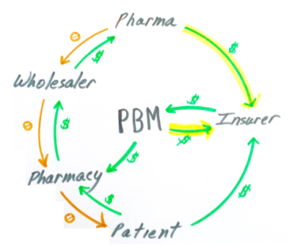The Basics of Pharma Kickbacks – Opaque & Complex
Posted on | March 7, 2018 | 2 Comments

Mike Magee
With great fanfare, the New York Times announced this week that UnitedHealthcare “would stop keeping millions of dollars in discounts it gets from drug companies and share them with its customers.” For awhile, pharma, insurers, pharmacies and PBMs have been pointing fingers at each other over escalating costs. That’s become more difficult of late with vertical integration moves from the likes of CVS and United Healthcare which not only own PBMs, but are also providing direct health services.
Former Lilly exec and new head of HHS, Alex Azar, applauded the move as “a prime example of the type of movement toward transparency and lower drug prices for millions of patients that the Trump administration is championing.” But in reality the move was defensive and will benefit only a small number of UnitedHealth Group patients.
The system outlined above in quick scribble is a complex exercise in backscratching, legal pay off’s, and inefficiency that proves the old adage that “one man’s waste is another man’s wealth.”
The flow of pills depicted above is pretty straight forward: From manufacturer to wholesale middlemen to pharmacies to us. But the flow of money is anything but straightforward. Three decades ago Merck purchased the Pharmacy Benefit Manager Medco which eventually became so profitable it overshadowed Merck.
PBMs are now the Grand Central Station of legal drug money and data transfers. They negotiate the deals for each and every drug with pharma, placement of those drugs on insurers tiered insurer lists, and integrate the data with pharmacies and insurers nationwide. Their cut-outs and give-backs are non-transparent, and nearly everyone is in on the deal – except you.
After you chose your pharmacy plan and pay your bill, money flows from you (in the form of deductibles and co-pays), to the pharmacy, who paid the wholesaler, who paid the drug company. But the payments don’t end there. The insurer gets kick-backs from the drug companies and PBM’s in thanks for choosing the preferred product, and the PBM keeps track of your insurance profile and money transfers to your pharmacy as efficently as Western Union – for a price, of course.
It’s confusing – and its big, very big. Here are a few numbers:
- Quantity: 4 1/2 billion prescriptions filled each year – 90% generic.
- Consumption: 50% filled 1 prescription in the past 30 days – 10% on 5+ prescription drugs.
- Construction: Majority of raw materials produced overseas by a $46 billion dollar manufacturing conclave.
- First stop – Wholesalers: 85% go through one of three middlemen – AmerisourceBergen, Cardinal Health, and McKesson – a $400 billion + cost to Americans.
- Retail: 60,000 pharmacies collect about $365 billion in revenue a year. Chains control 74% of all retail income – 62% in person and 38% by mail order.
- Who Pays?: Ultimately, we do! Along the way, almost everybody, but us, gets a kickback.
- What about Insurers? 86% of drug bill is paid by insurers – but they are paying with your premium dollars, and kickback dollars from drug companies and PBMs.
- Cost Control: Insurers use PBMs to hold down their costs. They create the tiered drug coverage plans, negotiate prices with drug companies, and manage the computer payment systems. The top three are owned by CVS (CVS Caremark), UnitedHealth Group (UnitedHealthOptum), and a mail order pharmacy (Express Scripts).
Free enterprise loves complexity. Why? It’s hard to read, harder to dismantle, and adds profit every step along the way. Case in point – Cigna’s $67 billion dollar offer this week to buy ExpressScripts, the nation’s largest PBM. Cigna CEO David Cordani laid out his reasoning in black and white.
“When we think about Express Scripts, it has PBM capabilities, but it has 27,000 individuals and a significant number of consumer touchpoints around health and well being. It expands our service portfolio beyond that of a PBM. Having the capabilities to serve an individual whether they are healthy, healthy at risk, chronic or acute is important.”
Tags: Cina > cvs > Express Scripts > PBM > Pharm distribution > pharma costs > pharmaceutical supply chain > Pharmaceutical wholesalers > pharmaceuticals > pharmacies > UnitedHealthcare
Comments
2 Responses to “The Basics of Pharma Kickbacks – Opaque & Complex”



March 13th, 2018 @ 3:14 pm
Excellent article. As a provider, of pharmaceutical competitive intelligence we have looked at kickbacks for several companies. It is very convoluted and there seems to be spectrum of activities. I believe there is Sunshine act which regulates this to certain degree but as always, there are creative solutions around every measure.
March 19th, 2018 @ 10:34 am
Good analyses. True, following the flow started how the medicine develops and sell it to the patients is very complex. The medicine cost is very high, it will never go down.